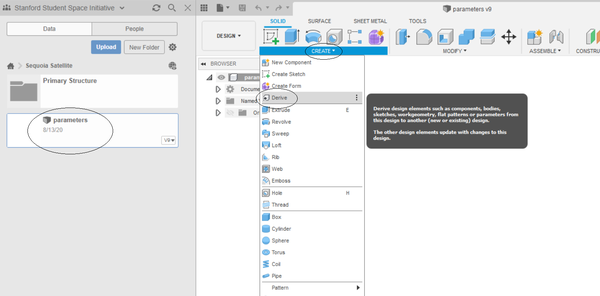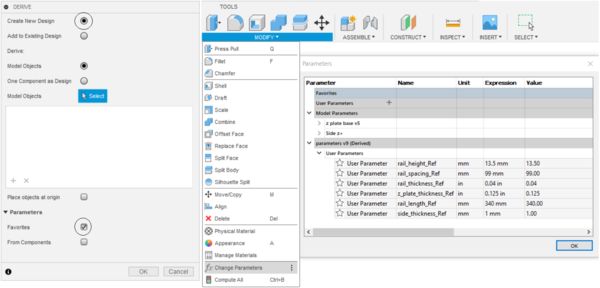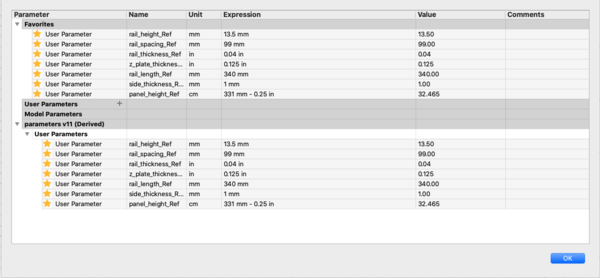Difference between revisions of "Sequoia structures"
| (14 intermediate revisions by 4 users not shown) | |||
| Line 1: | Line 1: | ||
| − | == | + | == Looking for Structures Onboarding? == |
| − | + | Head over to this [https://wiki.stanfordssi.org/Satellite_Structures_Onboarding page]! | |
| − | |||
| − | |||
| − | + | == Designing Parts: A Simple Workflow == | |
| + | First off, enter the Sequoia project on Fusion SSI team. This can be done by clicking your name in the upper left hand corner, after which a dropdown menu should appear. Select Stanford Student Space Initiative and then enter Sequoia Satellite. | ||
| − | + | Now, you should see some files and some folders. We are interested in the 'parameters' to begin with. It contains satellite-wide dimensions (for example, rail dimensions and spacing, material thickness, and more) which any new part will need access to. To make a new file with access to these dimensions, open the parameters file, open the create menu and hit derive. | |
| − | [ | + | [[File:deriving_parts.png|600px]] |
| − | + | This will open up a dialogue asking what to derive to where. We will be creating a new part and copying over the parameters; select the same options as below. After hitting okay, it will open an empty, untitled file. However, if hit 'modify' then 'change parameters', it will open a dialogue which shows the imported global parameters after expanding the menu. | |
| − | + | ||
| − | + | [[File:Deriving_parts2.png|600px]] | |
| + | |||
| + | You can now click on the star icons on the left side of each of the global parameters. After clicking the icons the global parameters will show in the favorites table and you will be able to reference them by name.(Note: this is optional but recommended because it enables tab complete, otherwise you have type in the full name of the parameter) | ||
| + | |||
| + | [[File:Deriving_parts3.png|600px]] | ||
| + | |||
| + | Now, hack away and CAD up a new part! The global parameters can be used by simply typing in a dimension's name (with an appended _Ref) (with an equation if you like) (ex: 3 * rail_height_Ref). After that, save it in an appropriate subdirectory and it will automatically appear for everybody else. | ||
| + | |||
| + | Sometimes, you may wish to make a part which is derived from another. In this case, open the file which acts as a base, and open the derive menu again. This time, under the Deriving selection, choose 'one component as design', and click on the part. It will also create a new file, but this time with the base geometry in it. As the base file gets updated, the derived part will too. | ||
== Details == | == Details == | ||
[[Design Objectives]] | [[Design Objectives]] | ||
| + | |||
| + | There are a few important design features which anything we create should be abide by. | ||
| + | |||
| + | # Anything we make needs to be easily manufacturable. Practically, this means we should try to keep our parts either 3D printed (almost any geometry will fly, but the materials won't be as strong) or simple to make from metal. For the latter, this practically means machined from stock with only operations like drilling/milling holes or other shapes which can be cut with a standard 3 axis mill. If what that means is unclear, feel free to ping Connor and check out parts of the primary structure. | ||
| + | # Our design should be flexible with regards to 'critical system parameters'. What does this mean? Let's say we start by designing the satellite with 1 millimeter thick metal. Life is great, but as the system becomes more complicated, more and more things start to depend on this value. Now we run a simulation or perform a test, and hey 1mm isn't strong enough. By defining global parameters which parts are derived from, it should be possible to modify this on the fly, and let the well designed parts accept a new parameter. Again, feel free to ask if it's unclear what exactly this means in practice. | ||
| + | # (On the pure technical front), we demand a safety factor of 5x from simulations running qualification-level inputs for the primary structure. This means that the stress in the metal is less than 1/5 of it's yield strength. Why such a big factor? Literally everything in this process is unpredictable, from material properties to manufacturing to modeling errors to the actual way forces couple from the launch vehicle. This ensures we will be completely safe. (Also, we are nowhere near our mass constraints, so no harm there). | ||
| + | # Deployment failures either are failsafed (two separate things would have to break for things to go wrong) or not mission-critical. We don't want to go through all the work to put this piece of metal in space just for a resistor to not get hot enough to melt our fishing line. | ||
| + | # The system is accessable/assembleable. Theoretically, what this means is when designing keep in mind there will be connectors and bolts everywhere and to make sure they can be manipulated easily. Practically, this probably means we'll make a prototype, identify the biggest headaches and fix them. | ||
[[Features]] | [[Features]] | ||
| + | # Primary structure machined with: 1mm lasercut aluminum for side panels, .040 inch (for sourcing reasons) thick aluminum angle for the rails, and lasercut 1/8 aluminum for z plates. The only thing which can't be done with simple lasercutting is drilling a few holes in the sides of the z plates. | ||
| + | # Many deployables. We have an extra set of solar panels on each side to increase power intake and hopefully therefore processing, a deployable patch antenna to increase downlink bandwidth, and a deployable dipole antenna. | ||
| + | # (to be designed) a set of magnetorques and reaction wheels to control satellite pointing. | ||
| + | # 3D printed clamping mounts for our massive camera lens. | ||
Latest revision as of 06:42, 17 September 2020
Looking for Structures Onboarding?
Head over to this page!
Designing Parts: A Simple Workflow
First off, enter the Sequoia project on Fusion SSI team. This can be done by clicking your name in the upper left hand corner, after which a dropdown menu should appear. Select Stanford Student Space Initiative and then enter Sequoia Satellite.
Now, you should see some files and some folders. We are interested in the 'parameters' to begin with. It contains satellite-wide dimensions (for example, rail dimensions and spacing, material thickness, and more) which any new part will need access to. To make a new file with access to these dimensions, open the parameters file, open the create menu and hit derive.
This will open up a dialogue asking what to derive to where. We will be creating a new part and copying over the parameters; select the same options as below. After hitting okay, it will open an empty, untitled file. However, if hit 'modify' then 'change parameters', it will open a dialogue which shows the imported global parameters after expanding the menu.
You can now click on the star icons on the left side of each of the global parameters. After clicking the icons the global parameters will show in the favorites table and you will be able to reference them by name.(Note: this is optional but recommended because it enables tab complete, otherwise you have type in the full name of the parameter)
Now, hack away and CAD up a new part! The global parameters can be used by simply typing in a dimension's name (with an appended _Ref) (with an equation if you like) (ex: 3 * rail_height_Ref). After that, save it in an appropriate subdirectory and it will automatically appear for everybody else.
Sometimes, you may wish to make a part which is derived from another. In this case, open the file which acts as a base, and open the derive menu again. This time, under the Deriving selection, choose 'one component as design', and click on the part. It will also create a new file, but this time with the base geometry in it. As the base file gets updated, the derived part will too.
Details
There are a few important design features which anything we create should be abide by.
- Anything we make needs to be easily manufacturable. Practically, this means we should try to keep our parts either 3D printed (almost any geometry will fly, but the materials won't be as strong) or simple to make from metal. For the latter, this practically means machined from stock with only operations like drilling/milling holes or other shapes which can be cut with a standard 3 axis mill. If what that means is unclear, feel free to ping Connor and check out parts of the primary structure.
- Our design should be flexible with regards to 'critical system parameters'. What does this mean? Let's say we start by designing the satellite with 1 millimeter thick metal. Life is great, but as the system becomes more complicated, more and more things start to depend on this value. Now we run a simulation or perform a test, and hey 1mm isn't strong enough. By defining global parameters which parts are derived from, it should be possible to modify this on the fly, and let the well designed parts accept a new parameter. Again, feel free to ask if it's unclear what exactly this means in practice.
- (On the pure technical front), we demand a safety factor of 5x from simulations running qualification-level inputs for the primary structure. This means that the stress in the metal is less than 1/5 of it's yield strength. Why such a big factor? Literally everything in this process is unpredictable, from material properties to manufacturing to modeling errors to the actual way forces couple from the launch vehicle. This ensures we will be completely safe. (Also, we are nowhere near our mass constraints, so no harm there).
- Deployment failures either are failsafed (two separate things would have to break for things to go wrong) or not mission-critical. We don't want to go through all the work to put this piece of metal in space just for a resistor to not get hot enough to melt our fishing line.
- The system is accessable/assembleable. Theoretically, what this means is when designing keep in mind there will be connectors and bolts everywhere and to make sure they can be manipulated easily. Practically, this probably means we'll make a prototype, identify the biggest headaches and fix them.
- Primary structure machined with: 1mm lasercut aluminum for side panels, .040 inch (for sourcing reasons) thick aluminum angle for the rails, and lasercut 1/8 aluminum for z plates. The only thing which can't be done with simple lasercutting is drilling a few holes in the sides of the z plates.
- Many deployables. We have an extra set of solar panels on each side to increase power intake and hopefully therefore processing, a deployable patch antenna to increase downlink bandwidth, and a deployable dipole antenna.
- (to be designed) a set of magnetorques and reaction wheels to control satellite pointing.
- 3D printed clamping mounts for our massive camera lens.


